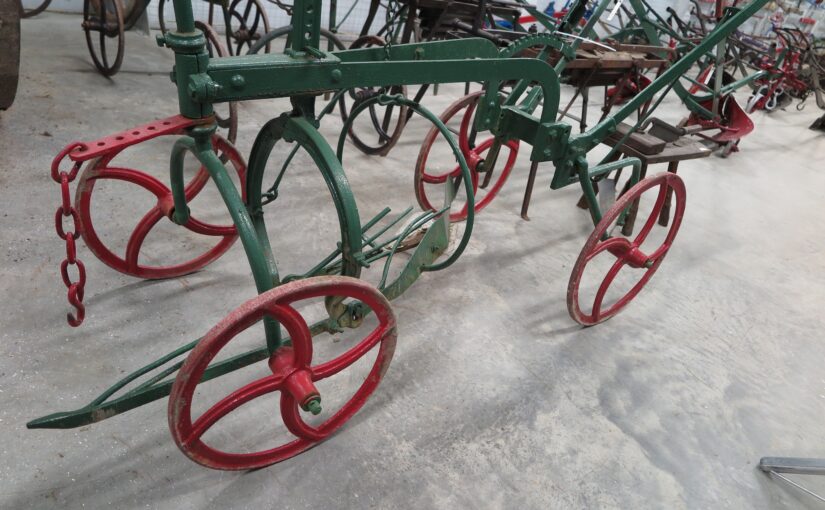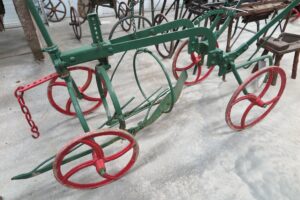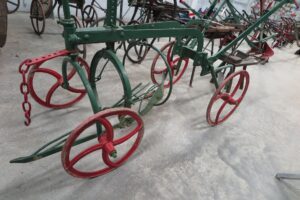Lifting turnips has always been regarded as one of the labour-intensive tasks on the farm. Not surprisingly, there have been a number of attempts to try to make harvesting of the crop a lot easier, whether in topping or tailing the turnips or both.
By the mid 1870s when the price of agricultural labour was rapidly increasing and labour was no longer as readily available as in previous decades, there were a number of competitions to try to find and demonstrate a satisfactory turnip harvester. These were undertaken by national societies such as the Royal Highland and Agricultural Society of Scotland and local and regional societies such as those in Banffshire.
Turnip lifting trials were widely reported in the newspaper press, both agricultural and non-agricultural. One trial that received significant coverage was held in Banffshire, under the auspices of the United Banffshire Agricultural Society. It sets out the background to the event as well as the different machines available and their working mechanisms. Interestingly, most of the makers were local to the north east, the exception being Hunter of Maybole, located in another area where there were significant acreages of turnips grown.
The following account, published in the Aberdeen press and journal on 6 December 1877 provides much detail on the trial and the machines:
“A competition in a branch of agricultural machinery which is at present attracting much attention took place on Tuesday on the farm of Rettie, near Banff. Turnip lifting has always been – mainly in consequence, perhaps, of the inclement season at which it has to be performed – a laborious and painful task. Strange to say, the work is almost invariably done by females, who it might be expected would be unable to withstand the cold and its accompaniments, and who at least suffer exceedingly in the performance of the duty. Since the passing of the Education Act lads cannot be obtained, and the wages of men are too high to admit of their being put to such work. Undoubtedly, therefore, the question of providing a machine which should perform the work of topping and tailing the roots in such a manner that it might fairly be considered a substitute for hand lifting is one of considerable interest to turnip growers. Inventors have always found it a work of comparative ease to produce an implement which would, on an average, top every alternate turnip. And which, when it did not slice the roots in halves, might be relied on to tail them. But machines of this description are practically useless. In nearly all machines the mechanism for tailing the turnips is constructed on the same principle, and consists of a horizontal “coulter”, which travels along under the surface of the drill, and, having a sharp edge in front, deprives the turnips of their roots. To apply a principle by which the work of topping can be performed seems, however, to have exercised the ingenuity of implement makers pretty widely. Of the machines entered on Tuesday for competition no two could be said to be alike in this respect. In one. Case, the “shaws’ were cut by knives in a manner almost similar to that of corn reapers; in another, a shaft was suspended over the drill, in the end of which three knives were fixed horizontally, and resolved with the shaft; another machine had a saw attached on each side, and ranging backwards and outwards so as to lop off each of the tops of one drill. In another case, the top of the turnip was forced between two knives, and in the last case a single knife, placed horizontally, executed the work. It will thus be seen that opinions differ widely as to the manner in which the operation should be performed, and from this it may well be supposed the composition attracted a good deal of interest.
The match was held under the auspices of the United Banffshire Agricultural Society, and three prizes were offered of £3, £2 and £1 each. Horses were provided for the purpose of draught, and on the farm of Rettie two fields-one of yellows and the other of Swedes-had been set at the disposal of the society. The following five makers entered and competed in the order in which they are given:-Thos Hunter, Maybole (double); Francis Murieston, blacksmith, Itlaw, Alvah (single); James McDonald, Black Jug, Portsoy (single); P. & T. Thomson, Corrinzion, Perth (Single); and D. Munro & Son, Forres (double).
The implements were started to work amongst the yellows, which, though very good comparatively speaking, were yet very thin and uneven. Here Munro’s machine was unfortunately incapacitated for work by the breaking of the lever, by which the tailing coulters were set into the ground. This occurred at the commencement of the trial of the implement, and as the fracture could not be repaired in time to take part in this portion of the competition, the machine was disqualified. The trial in this field having been completed, a move was made to the Swedes, were the four competing machines were started simultaneously. Several drills were operated upon, and a minute and careful inspection was made by the judges-Messrs James Runcieman, Castleton; Paterson, Auldton; and Ogilvie. Tillynaught. Their decision was given by Mr Runcieman, who said-we have no hesitation at all in saying that the first prize has been gained by Mr Francis Murieson, the second by Mr James McDonald, and the third by the Messrs Thomson. The last machine, that of Messrs Munro, did not compete in the yellows, and was consequently not in the field. We also wish to say that we were greatly pleased with the work of numbers one and two, which was all that we need expect from such machines, and the judges were a little surprised at the commencement of the work when they saw the performances of the others. I do not know that I should say more. We had to consider as to whether we were bound to award prizes at all, because a good many of the turnips were so badly cut as to be useless for storing, and this is fatal to the success of the machine. We were rather of opinion that unless we were actually bound to award the prizes we ought to withhold them altogether. The machines, however, may be good. They have come some of them far distances, and may work better under more favourable circumstances. We, however, have just to take them as we get them.
Mr Morrison, Loanhead-I think the decision of the judges is generally approved by the onlookers (Applause).
Mr Murieson’s machines is certainly a model of simplicity. It is, to begin with, of very light draught, can easily be managed by one horse, and takes one drill at a time. The topping apparatus seems to be almost complete in its arrangement. Between the front wheels two “skips” of wire (similar to the guides usually fixed on the extremity of the guards of corn reapers to part the corn for the knives) are suspended. They are placed close beside each other, the space between them being only sufficient to allow the top of a turnip to pass. Two blades are fixed between the “skips” in scissor fashion, so that anything which gets between the skips is cut on passing back. The skips are so joined together that they may be called double, and the mode of working is this-whenever the point of the double skip (which is turned up snow shoe fashion) strikes a turnip it lifts up and passes over the object. The shaws, however, are caught between the skips, and travel back to the knives. These latter are so placed that when the root reaches them the knives lop off the tops and do not touch the turnip itself. The shaws are then run off to one side by a slanting board, and the tailing is performed by a horizontal; “coulter”. The Portsoy machine is constructed on a principle somewhat similar. The tops are caught between projecting wirework, and in passing back are cut by a horizontal knife, while a coulter tails the roots and shoves them off to the right side. This machine costs about eight guineas, as also does Mr Murieson’s. The third prize machine is of rather heavier draught than the other two. For topping the turnips two shafts are suspended over the drills (of which two are lifted each round). In the end of each shaft three knives are attached horizontally, and revolve along with the shaft. A coulter tails the roots, which are then caught by a wheel in potato digger fashion and flung out to the right side of the drills. This machine took the first prize at a competition held under the auspices of the Highland and Agricultural Society at Inverurie last year, and cost 19 guineas. Of the other machines Mr Hunter’s tops the roots by means of saws, and that of the Messrs Munro performs this work in corn reaper fashion.
After the competition the judges and a few friends dined at the house of Mr Longmore, Rettie, and a pleasant evening was spent.
The day was dry and otherwise favourable, and a good many influential farmers and others watched the competition very closely. The ground in both fields was very stiff, and added considerably to the draught of the machines.”
The photos of the Ferret turnip harvester from the 189-s onwards were taken at the Highland Folk Museum, May 2016.


